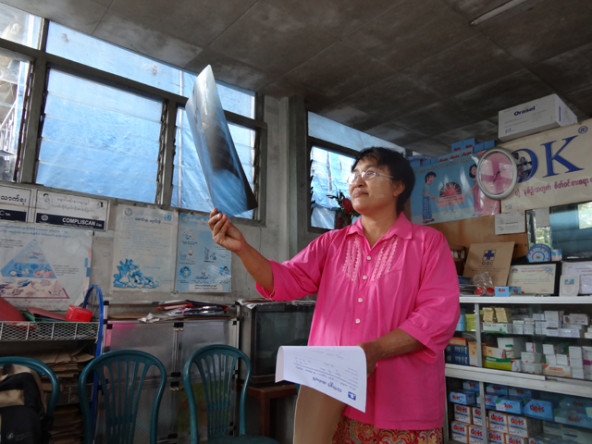 A provider at Sun Quality Health, a Population Services International (PSI) network of private clinics in Myanmar providing TB care, as well as family planning and child health services. (Photo by Regina Moore/PSI)
A provider at Sun Quality Health, a Population Services International (PSI) network of private clinics in Myanmar providing TB care, as well as family planning and child health services. (Photo by Regina Moore/PSI)
While seemingly intractable health care debates rage stateside, startups, corporations, NGOs, and governments in developing countries are leapfrogging traditional health care structures and creating innovative, context-specific solutions to their health care challenges—as was captured in the recent article “The Future of Health Care Access.”
The Center for Health Market Innovations (CHMI) has been identifying such solutions since 2010. Every year, we review our programs database (we currently profile more than 1,200 programs working in 122 countries) to identify promising models and practices, new ways of addressing health challenges, and how organizations are growing and refining their ability to serve poor communities. Here are a few top-line messages from this year’s report, “Highlights: 2013.”
1. Government is providing support for market-based health care in India’s huge and growing private health sector.
In India, where we profile 249 programs (significantly more than in any other country), health care organizations are testing new methods to leverage both public and private resources to meet the health needs of the poor. While India’s government has traditionally prioritized providing needed health services to the poor through public facilities, CHMI—in collaboration with ACCESS Health International and Swasti Health Resource Center—has identified growing numbers of public-private partnerships.
Of the 50 public-private partnerships we’ve profiled in India, at least 15 of these programs support health call centers or provide emergency services. In addition, several programs use NGOs to increase access to specialized services, including family planning, cancer diagnosis, and tuberculosis (TB). The Mahavir Trust Hospital trains private practitioners around Hyderabad to identify and refer TB patients to private clinics for government-provided treatment. These partnerships also allow the government to augment the capacity of its directly administered public health system. For example, the eastern state of Orissa contracted with a local NGO, NYSASDRI, to overhaul a number of previously defunct primary health centers.
2. Creative health solutions are emerging in fragile states.
Are you enjoying this article? Read more like this, plus SSIR's full archive of content, when you subscribe.
Fragile states—those with unusually weak governance, policies, and institutions—are home to more than one-third of the world’s poor and experience an unusually high incidence of disease. In many of these countries, organizations are adapting pharmacies and products to use in isolated or displaced communities. Healthy Entrepreneurs’ Pharmacy-In-A-Box is a small pharmacy stocked with 25 essential generic medicines tailored to the specific health needs and infrastructure realities of rural communities. Healthy Entrepreneurs operates in five countries, including the fragile states of Burundi, the Democratic Republic of the Congo, and Haiti.
3. Supply chain advances are improving access to quality medicines.
A host of new initiatives are working to ensure that patients have access to life-saving preventive and curative medicines. Along the four principal components of supply chains—production, procurement, distribution, and delivery—there are several promising new approaches. Clinics4All uses commercial supply chains to increase access to medicines across Africa and Asia, as does Population Services International in Angola, Somaliland, and South Sudan.
4. Innovators are harnessing informal health providers to extend access to health care.
Informal health providers—also known as village doctors, drug sellers, or myriad other names—are a vital source of care for many. They represent a large proportion of available health care providers, comprising more than 50 percent of health care workers in India and close to 96 percent in rural Bangladesh. According to studies conducted in Bangladesh, Nigeria, and India, these providers are deeply embedded in the communities where they work.
With proper interventions, we can harness many informal providers to expand access to health care. For example, World Health Partners serves communities in rural Bihar and Uttar Pradesh, India, by franchising and training the unlicensed, informal practitioners who were already providing services within these communities.
5. A number of emerging health care models demonstrate scale-up potential.
As has been widely reported, it is exceedingly difficult for health programs to reach scale in developing countries. Sourcing effective personnel, mastering quality standards, balancing affordability with revenue requirements, and developing an effective business model are just a few of the many hurdles.
Yet at least 40 pro-poor health organizations from our data set have reported that they have scaled up in the past year by expanding the number of networked or accredited facilities, increasing the number of clients they serve, or expanding the breadth of services they offer. For example, the door-to-door sales agent model HealthKeepers (modeled on the Avon lady distribution network) increased the number of clients it reached in Ghana from 300,000 to 646,680 in the past year, thanks in part to USAID support. And, in India, the emergency transport service Ziqitza Health Care Limited nearly doubled its ambulance fleet from 460 to 860, largely due to government contracts.
We will continue to track the growth of developing country health markets. But the question still remains: Which organizations are achieving health and financial results important to national and global health policy makers, donors, investors, and other health care managers? A standardized set of performance metrics could help fairly compare organizations and set reliable benchmarks. The good news is we’re working on that, in collaboration with others such as the Impact Investment & Reporting Standards (IRIS) team at the Global Impact Investing Network.
With a better understanding of which health organizations in these extremely dynamic health markets are having an impact, we can better track and support the scale up of care that is measurably improving the lives of the poor.
Support SSIR’s coverage of cross-sector solutions to global challenges.
Help us further the reach of innovative ideas. Donate today.
Read more stories by Donika Dimovska.

